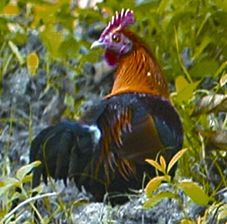Junglefowl
Junglefowl gamebirds of the genus Gallus of the family Phasianidae, order Galliformes. These birds are found in many Asian forests. Once it had the closest association with humans. The genus Gallus has four species; Bangladesh has one, the Red Junglefowl, Gallus gallus. Of the other three species, the Grey Junglefowl, G. sonnerati, occurs in western, central and southern India.

The cock of this species has neck hackles which is dilated. Its call is more like a cackle. The Ceylon Red Junglefowl, G. lafayetti, is confined to Sri Lanka. The cock has a yellow comb with a red edge and is red beneath. The other species of junglefowl is G. varius. It inhabits the Malay islands. It does not have hackles on the neck, but the cock has a large unserrated comb.
Of all junglefowls, the Red Junglefowl is the most important. Archaeological evidence reveals that the Red Junglefowl, G. gallus, was first domesticated in India about 5,200 years ago and since then has been providing eggs and meat to all humans on earth. This species was once found in almost all forested areas of Bangladesh. It now occurs in the forests of Sylhet, Chittagong, Chittagong Hill Tracts and the Sundarbans. The male bird is orange-red with long yellowish hackles on the neck. It has elongated lanceolate feathers on the rump. The underpart is chiefly blackish brown.
The crown of the female is dull rufous; its upperpart is reddish brown and underpart light rufous-brown. The bird moves in small parties. The group size is usually 5-6, and consists of a cock and 4-5 hens. It feeds on all kinds of grain, shoots of crops and grass, fruits, berries, insects, and occasionally small vertebrates; it even feeds on human excreta. The call of the cock is similar to that of the domestic fowl, but is somewhat shriller. March to May is the main breeding season. Eggs resemble those of the domestic fowl; usually 4-6 eggs are laid. The hen alone incubates and the incubation period is about 21 days. [Md Anwarul Islam]
